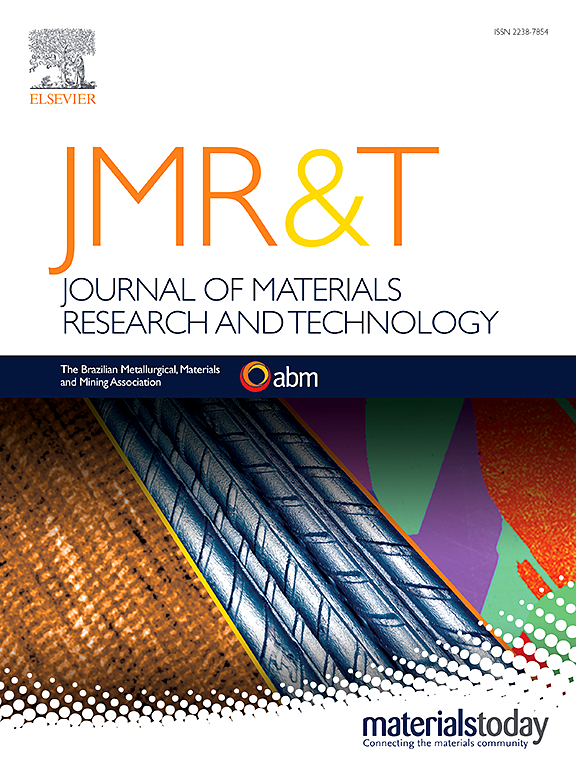提高硬度和耐蚀性的多主元素合金的开发和表征
IF 6.6
2区 材料科学
Q1 MATERIALS SCIENCE, MULTIDISCIPLINARY
Journal of Materials Research and Technology-Jmr&t
Pub Date : 2025-06-02
DOI:10.1016/j.jmrt.2025.05.240
引用次数: 0
摘要
多主元素合金(MPEA)具有许多优点,具有广泛的应用前景。在这项研究中,我们设计并制造了三种新型的mpea,用于核后处理和化工厂的侵略性高浓度氧化性硝酸,准确地称为中熵合金(MEA),合金元素为Ti, Ta, Nb和Zr。Sample1(S1)由相同原子百分比的Ti、Ta和Nb组成(Ti0.33Ta0.33Nb0.33 at%);sample2 (S2)含有(Ti0.84Ta0.1Nb0.06 at%),而sample3 (S3)的化学成分为(Ti0.33Ta0.33Zr0.33 at%),样品S1和S3所含的构成元素原子百分比相等。x射线衍射(XRD)和显微镜研究表明,S1和S2只含有β相。相反,S3由α相和β相的混合物组成。S1和S2的维氏硬度值分别为202和206 HV。而S3试样的硬度值在260 HV左右。动电位极化研究表明,S1和S2表现出相似的腐蚀行为,而S3在11.5 M硝酸介质中表现出意外的腐蚀行为。在相同的溶液中进行沸腾腐蚀试验,S1和S2没有失重,而S3的腐蚀速率高达156 mpy (3.96 mm/yr)。采用激光拉曼光谱(LRS)、x射线光电子能谱(XPS)和辉光发射光谱(GDOES)对腐蚀试样进行了表征,讨论了硬度和耐蚀性的关系。本文章由计算机程序翻译,如有差异,请以英文原文为准。
Development and characterization of multi-principal elemental alloys for improved hardness and corrosion resistance
Multi-principal Element Alloys (MPEA) have several advantages, and it has a wide range of applications. In this study, we have designed and fabricated three novel MPEAs for aggressive higher concentration oxidizing nitric acid application in nuclear-reprocessing and chemical plants, precisely called medium entropy alloys (MEA), with alloying elements Ti, Ta, Nb, and Zr. Sample1(S1) consists of an equal atom percentage of Ti, Ta, and Nb (Ti0.33Ta0.33Nb0.33 at%); sample2 (S2) contains (Ti0.84Ta0.1Nb0.06 at%), whereas the chemical composition of sample3 (S3) is (Ti0.33Ta0.33Zr0.33 at%), sample S1 and S3 contain equal atom percentage of constitute elements. X-ray diffraction (XRD) and microscopy studies revealed that S1 and S2 contain the β phase exclusively. In contrast, S3 comprises a mixture of α and β phases. The Vickers hardness values for S1 and S2 are 202 and 206 HV, respectively. In contrast, the hardness value of specimen S3 was around 260 HV. The potentiodynamic polarization study reveals that S1 and S2 show similar corrosion behavior, whereas unexpected corrosion behavior has been observed for S3 in an 11.5 M nitric acid medium. A boiling corrosion test in the same solution exposes no weight loss for S1 and S2, whereas S3 shows a high corrosion rate of 156 mpy (3.96 mm/yr). The corrosion-tested specimens were characterized by using Laser Raman Spectroscopy (LRS), X-ray photoelectron spectroscopy (XPS), and Glow Discharge Optical Emission Spectroscopy (GDOES) in correlation with hardness and corrosion resistance are discussed.
求助全文
通过发布文献求助,成功后即可免费获取论文全文。
去求助
来源期刊

Journal of Materials Research and Technology-Jmr&t
Materials Science-Metals and Alloys
CiteScore
8.80
自引率
9.40%
发文量
1877
审稿时长
35 days
期刊介绍:
The Journal of Materials Research and Technology is a publication of ABM - Brazilian Metallurgical, Materials and Mining Association - and publishes four issues per year also with a free version online (www.jmrt.com.br). The journal provides an international medium for the publication of theoretical and experimental studies related to Metallurgy, Materials and Minerals research and technology. Appropriate submissions to the Journal of Materials Research and Technology should include scientific and/or engineering factors which affect processes and products in the Metallurgy, Materials and Mining areas.
 求助内容:
求助内容: 应助结果提醒方式:
应助结果提醒方式:


